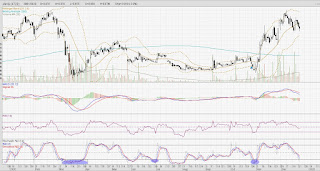In my previous article, we discussed about What Moves Share Prices. In that article, it is mentioned that Sentiments that is the key factor that affects and moves share prices. Now, knowing that the main contributor of share price movement is due to sentiment, how can we benefit from it? Remember one of the main mantra of Value Investing is "Price is what you pay and Value is what you get".
I personally champion fundamental analysis and also a believer of Value Investing. However, since sentiment is not quite fundamental but it has to do with human behaviors and psychology, I will use mainly Technical Analysis method to select stocks and look out for opportunities.
1. Buy on Dips (if the overall market is on an uptrend)
If the investor has identified that the market is on a recovery and uptrend, buying during any dip is a feasible and proven option. As markets don't go up in a straight line, it's imperative that it'll correct itself once in a while and provide investors a good entry point to accumulate more shares. Normally in an uptrend market, actual data will provide support to the higher valuation and continuity of the bull market.
2. Buy on Price Irrationality (a combination of fundamental and technical analysis)
Often, there are companies that are selling below their intrinsic value. Some examples include property developers like SP Setia, Sime Property of even Banks like Ambank, CIMB, Affin Bank selling at 0.3 to 0.7 times of the book value. The prices are beaten down because of slow sales and anticipated massive impairments. However, if one were to look further and past the pain, most of these companies will bounce back strongly and valuation will rise certainly.
3. Buy on Supports (Technical Analysis) I will not go in too detail as it involves a separate lesson on how to use each of the indicators (or a combination of them) effectively. Some examples as below:
a. Using Bollinger Band
b. Using RSI (oversold region <30%)
c. Using Stochastic
4. Using Contrarian Investing Strategy
Contrarian Investing is an investment strategy that is characterized by purchasing and selling in contrast to the prevailing sentiment of the time. A contrarian believes that certain crowd behavior among investors can lead to exploitable mis-pricings in securities. I have been using this strategy for over 12 years and it has been proven to be very profitable.
However, risk management is key as when market sours, it normally means that businesses are suffering. This means that there will be some companies who will be bankrupt during the downturn. So, in order to exploit this method, you will have to study the balance sheet and fundamentals of the companies before you invest in them. This strategy involves buying companies' shares when stock market is having 'big discounts' (think of massive clearance sales) and hold them over a period of 2-5 years.
Conclusion
The above are some examples of strategies can be employed to profit from the stock markets. In the traditional market (non derivatives or structured products), the only way to profit is to "buy low sell high". For more advance or sophisticated investors, you may explore further instruments like warrants and futures which would allow you to bet both ways (able to profit when market is going up or down). However, the risks associated to it are normally higher as Warrants have an expiry date and normally trading at a premium to the underlying value. While Futures is normally purchased based on calendar month, it has a value (i.e. HKD10 per point for Mini-HangSeng) attached to the points movement. For investors wanting a smaller exposure it might not be suitable.






